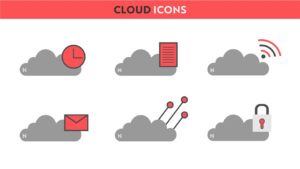Many business owners or their senior leaders are unclear about technology applications, including document management and digitization. Technology is a tool that can enhance and improve your business processes.
What is digitization? To many, it means going paperless, but it really is more than that. The interchangeable use of digitization, digitalization, digital transformation, digital technology and even automation in the world of process improvement serve to fuel the confusion.
The era of digital technology is here to stay, and savvy small and medium-sized business owners know they need to understand differences in terminology and how they may be applied to their business through process improvements, or get external resources to help them.
Gone are the days of piles and piles of paper documents, as document management and digitization have taken over the driver seat! Take a quick Business Self-Assessment to see how your business is doing.
“A Non-Compliant Document Management Strategy is Equivalent to NO Strategy”
Process Management in Your Business

Every business requires a strategy to use technology to create a leaner business including managing documents and records.
Depending on the nature, size and needs of the business, this might be a simple Microsoft program, or involve the use of more sophisticated software.
Failure to do so results in an inefficient system that uses time-consuming methods – manual, paper or spreadsheets, with information being difficult to cross-reference.
Such a system is prone to inconsistencies and inaccurate interpretation.
A company wide process management system can help to integrate processes – including document management – across different business areas.
This is the reason for always commencing any process improvement initiative with process mapping as it helps to identify areas of waste.
The benefits of streamlining and improving key processes are quickly seen in the business as increased efficiencies through speed and agility, collaboration, and a culture of continuous improvement.
Technology can be used to drive these results.
Let’s quickly review different technology terms to see how they may be applied to document management.
What is Digital Technology?
Digital technology is the adoption and application of a computer-based technology to enable collaboration of individuals towards achieving common goals and objectives.
There are currently eight broad categories of technologies with a staggering total of 89 vendors (BDC, July 2020). Selection of an appropriate technology from this pool can be an overwhelming task.
Document Management and Digitization – What is Digitization?

Digitization is the process of converting information into a digital computer-readable format. It involves creating a digital version of analog/physical things, converting non-digital paper documents, photographs, records etc. into a digital format which then can be used by a computing system for other functions.
Documents are digitized for a reason – to automate processes or workflows, ensure the latest revisions are being used, and provide audit trails.
Paper can very quickly clog up processes by creating disruptions to smooth information flows.
A non-compliant document management strategy is equivalent to NO strategy!
What is Digitalization?
Digitization and Digitalization appear similar and are often used interchangeably, but they are different.
Digitalization involves improving or transforming the operations of your business (or a specific area) by implementing digital technologies.
This includes turning your business models, communications, and processes towards a mix of digital and physical, while adding efficiency by reducing manual operations.
While digitization is more about creating record systems and getting your employees engaged, digitalization is about engagement as well as improvements by leveraging digitized data and processes.
Digitalizing your business creates functional digital business compartments such as a digital workplace, supply chain, marketing etc.
In general, digitalization is the fore-runner of digital transformation and new digital – revenue streams.
Digitalization goes beyond business alone but also highlights digital technologies across all our activities in society, such as the rise in the provision of customer service, customer shopping, healthcare etc..
Document Management and Digitization. What is Digital Transformation?

Digital transformation, as defined by Wikipedia is the use of new, fast and frequently changing digital technology to solve problems.
It is about transforming processes that were non digital or manual to digital processes. An example of digital transformation is Cloud computing.
Digital transformation is an ongoing process of using digital technologies to create new — or modify existing — business processes, culture, and customer experiences to meet changing business and market requirements.
The goal is to use technology to transform a service into a significantly improved service through innovation and achieve higher productivity with value delivery to customers and clients.
Digital strategies are designed and implemented differently for every company, depending on its goals, resources, and market reach.
Adapting to new technology and fully leveraging its features is imperative to the modern organization and it is what leads to digital transformation.”
Digital transformation is different for every company and is generally defined as the incorporation of digital technology into all or several areas of a business resulting in clearly defied operations with value delivery to customers and Clients.
What is Digital Process Automation?
Automation involves the creation of technology and its application in order to control and monitor the production and delivery of various goods and services. It performs tasks that were previously performed by humans.
Digital process automation helps automate business processes within an organization and improves overall effectiveness and efficiency. It assumes that the business processes have been digitized.
Document Management and Digitization – Benefits of Automation
These include the following:

- Increased customer focus and responsiveness
- Transparency across processes
- Automation of customer tasks
- Trigger of notifications and reminders
- Compliance related activities
- Collaborative environment
- Time savings
- Cost reductions
- Increased accuracy
- Adaptability
To gain these benefits, a business must critically review and select automation software to ensure that it can address the needs of the business.
How Does All this Tie into Document Management?
Document management systems help businesses store documents electronically and automatically. This approach requires digitization.
A document management system is an automated way of managing your files (processes and procedures). It includes classification, organization, security access, storage, version control and tracking.
Document management software make it easy for businesses to combine paper and digital files into a central location. A wide range of file formats can be supported including from Word documents, Excel spreadsheets, PowerPoint presentations, PDF files, images, maps and photographs etc.
Digitization is more than going paperless. Document management software systems incorporate several business functionalities – classification and indexing, document storage, security and access, search and retrieval, check-in / check-out, version control, team multi-user editing, version control and audit trails.
In Conclusion – Document Management and Digitization
BCINC can assist your business to navigate the terrain of digital technology requirements for document management and digitization. There are several factors that serve as drivers for document management and digitization.
Ensuring that adequate process mapping and process simplification are conducted before digitization is required for the success of whatever document management system is developed.
Book your NO OBLIGATION 30-minute Strategy Call to discuss about implementing document management and digitization or any other process improvement for your business
References
Business Development Canada (July 2020) Profit From Technology. Digital Tools to Drive Efficiency and Revenue
https://www.bdc.ca/en/articles-tools/technology/pages/default.aspx

